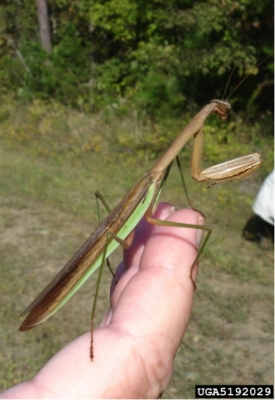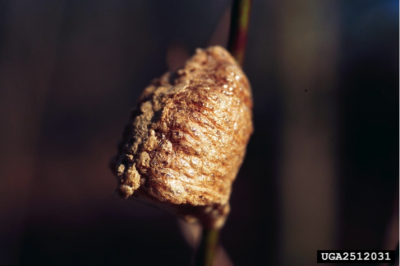By Donna Ellis, UConn, Department of Plant Science and Landscape Architecture, 2015.
The insect that we commonly refer to as a praying mantis is also known as a mantid. Praying mantids earned their nickname because they hold their forelegs bent and raised as if in prayer. These large, beautiful predators belong to the insect order Mantodea. Adult mantids common to our area range in length from 5 to 11 cm and have a distinctive appearance. They capture and feed on prey using large grasping forelegs with spines. Mantids can turn their triangular heads 180 degrees as they search for their next meal. Two large compound eyes and three simple eyes allow them to see up to 20 meters away. They have an elongated thorax, the middle of their 3 body segments, which gives the appearance of a “neck”.
Neither of the two mantids common to the US are native species. The European mantid (Mantis religiosa) is also known as the praying mantid. There are green and brown forms, with green being more common. The drab coloration of these insects helps to protect and camouflage them from predators. The Chinese mantid (Tenodera aridifolia sinensis) is a larger species, brown in color with yellow and green striping found on the sides of the wings. Mantid egg cases sold in garden centers and from online sources are typically from Chinese mantids.
Praying mantids can be found on plants with similar coloration to their bodies and in areas where other insects can be found. Mantids are predators of many types of insects, including flies, moths, grasshoppers, and crickets. They wait quietly, poised and ready until a prospective meal is within reach, then quickly grab the unsuspecting prey with their strong forelegs. This action occurs so fast that it can’t be seen with the naked eye. Mantids will feed on both harmful and beneficial insect species. A female mantid will often eat the male after mating.
The life cycle of mantids is an incomplete metamorphosis that includes eggs, an immature stage (nymphs), and adults. Female mantids lay hundreds of eggs each in papery sacs that they attach to weed or other plant stems. The egg sac is the overwintering life stage for the species, and the reinforced papery material provides protection from the elements during the colder months. When young mantids hatch in spring, these nymphs greatly resemble their adult parents but are much smaller and without wings.
The official state insect of Connecticut is the European or praying mantis, designated in 1977.
Allen Bridgman, South Carolina Department of Natural Resources, Bugwood.org
Praying mantid
Jim Occi, BugPics, Bugwood.org
Praying mantid egg case
References
Borror, D.J. and R.E. White. 1970. Insects. Peterson Field Guides. Houghton Mifflin Company, NY, NY. 404 pp.
Cranshaw, W. 2004. Garden Insects of North America. Princeton University Press, Princeton, N.J. 656 pp.
National Geographic, Praying Mantis, http://animals.nationalgeographic.com/animals/bugs/praying-mantis/

